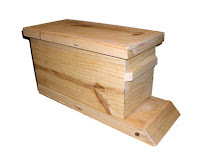

This is a view of inside of the worm bin. The bottom grate allows for worm castings to be raked to the collection tray by the rake that is mounted on top of the grate. The thought is that as I pull the rake, the castings will be dislodged to the collection drawer below. I insulated the inside of the worm bin with 3/4 inch rigid foam insulation to help keep a consistant temperature in the bin. The insulation also protects the worm bin from moisture.

This is a view of the rake that has been swept across the grate.

This is the handle of the rake that has been pulled to show you how this works.

The rake is now in its storage position

This is a view of the complete worm bin. It is mounted on 4 casters and has a drawer at the bottom to retrieve the worm castings. A top is not necessary. The idea is that the worms will stay in the top 4 inches of compost (where the food is). The waste will remain at the lower label where this is dislodged with the rake to be harvested. Simple in concept, I just hope it works.
 A view of the lower collection bin and drawer. Ventilation holes are also seen.
A view of the lower collection bin and drawer. Ventilation holes are also seen.
A better view of the collection tray with collection drawer.
 Drawer open for collection of excellent quality worm castings.
Drawer open for collection of excellent quality worm castings.Ok, So nothing is going on with the bees other than occasional feeding as needed. The remaining hives are looking good. I started reading about composting and thought this would be a good winter project. I began reading what I could on the web and decided to build a flow-through worm composting bin. I've seen several commercial ones on the net and a few basic ones made from plastic totes. I decided to build one of my own design based on a flow-through system. These systems are easily cleaned and castings are harvested relatively easily. I purchased about 2000 worms from a local worm grower for the bedding of my new worm bin. Check out the photo's. Maybe you will be entertained some how.


















































